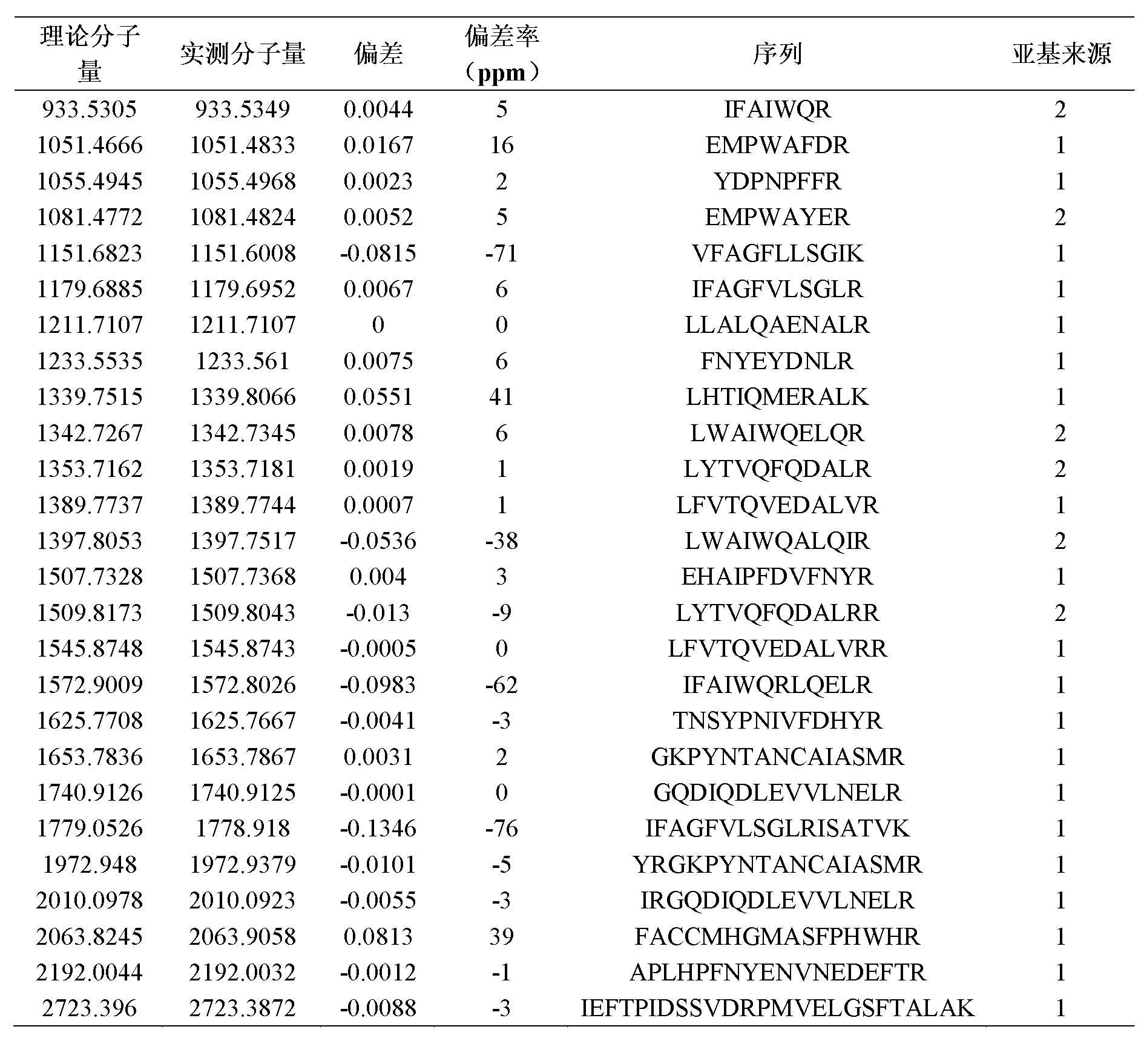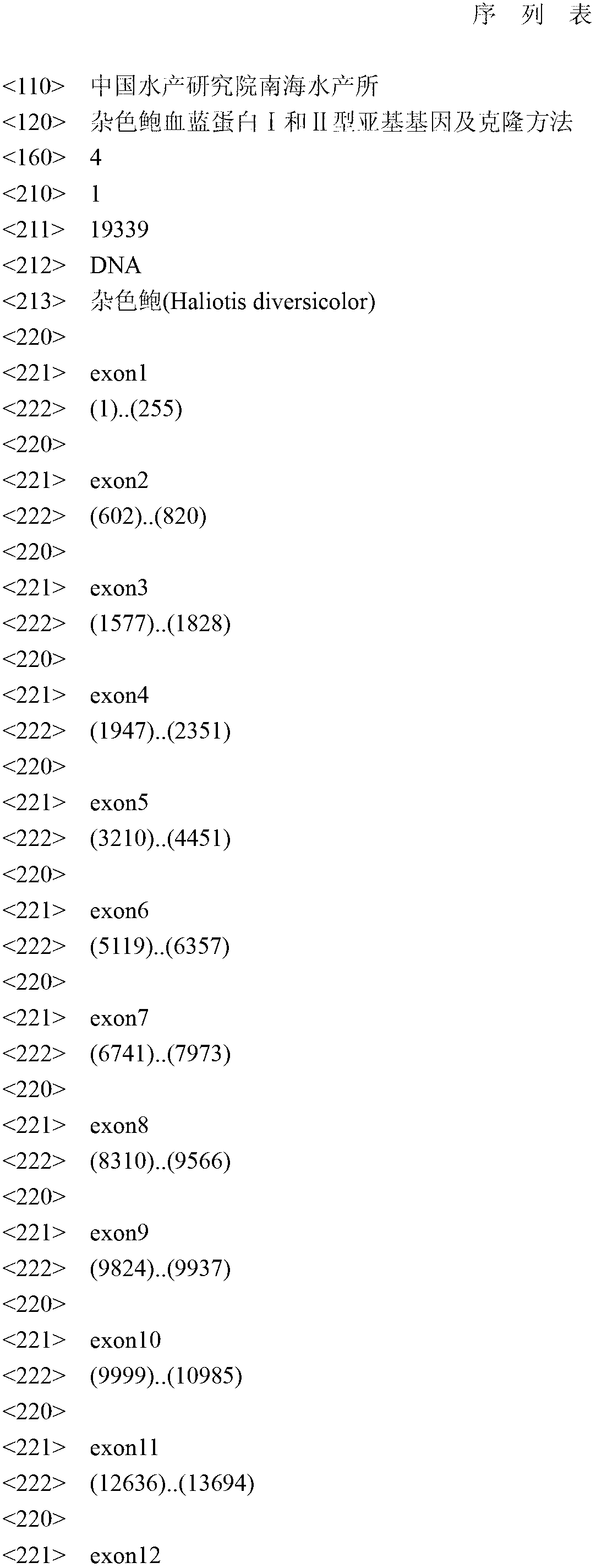Haliotis gigantea discus hemocyanin I and II type subunit genes and cloning method
A protein and abalone blood technology, applied in chemical instruments and methods, botanical equipment and methods, biochemical equipment and methods, etc., can solve the problems of large shellfish hemocyanin gene and high cost, and achieve the effect of reducing medical costs.
- Summary
- Abstract
- Description
- Claims
- Application Information
AI Technical Summary
Problems solved by technology
Method used
Image
Examples
Embodiment 1
[0033] Example 1: Extraction and Identification of Hemocyanin (Hc)
[0034] 1. Preparation of crude hemocyanin
[0035] Add the hemolymph of abalone variegated into a 1.5mL Eppendorf tube, centrifuge at 8,000rpm, 4°C for 30min, discard the precipitate, centrifuge the supernatant at 10,000rpm, 4°C for 30min, discard the precipitate, then centrifuge at 30,000rpm, 4°C for 1.5h, discard the supernatant It can be seen that there is a blue precipitate at the bottom of the tube, and crude hemocyanin is obtained. Add 1mL PBS buffer to the blue pellet to resuspend the pellet and store at -20°C.
[0036] 2. Purification of hemocyanin by density gradient centrifugation
[0037] Prepare 4 concentrations of CsCl solutions with PBS buffer and place them in gradient tubes, from the bottom of the tube to the top of the tube, they are 45%, 35%, 25%, and 15% (V / W). Add the hemocyanin extracted in step 1 to the top layer of the gradient tube, then centrifuge at 35000rpm, 4°C for 16h. A blu...
Embodiment 2
[0043] Example 2: Determination of Hemocyanin (Hc) Phenoloxidase Activity
[0044] 1. Determination of Hemocyanin Phenoloxidase Activity
[0045] The absorbance values of the purified hemocyanin (Hc) obtained in step 2 of Example 1 at different wavelengths were detected by an ultraviolet-visible spectrophotometer, and the concentration of Hc was detected by the Coomassie Brilliant Blue method. Determination of phenoloxidase activity was divided into control group and experimental group. The control group used PBS instead of variegated abalone hemocyanin, and the others were the same as the experimental group. In the experimental group, 100 μL of 3 mg / mL hemocyanin was added to 2.8 mL of PBS buffer, placed in a water bath at 25°C, and left to stand for 15 minutes; 100 μL of 18 mmol / L catechol was added, mixed well, and its Absorbance at 400nm. Repeat 3 times. Calculate the initial velocity of the reaction:
[0046] Vi=(TODe-TODc) / 3×molar absorptivity,
[0047] Among the...
Embodiment 3
[0051] Example three: HdHc1 and HdHc2 gene extraction
[0052] 1. Design of primers for HdHc1 and HdHc2 gene library screening
[0053] According to the HdHc1 and HdHc2 peptide sequences identified by mass spectrometry in Example 1, and the European tumor abalone (Haliotis tuberculata) hemocyanin type I and II subunit gene sequences (AJ252741 and AJ297475) with 90% homology in NCBI, design Specific primers were used to screen the complete gene sequences of HdHc1 and HdHc2 from the variegated abalone genome library.
[0054] The upstream primer of HdHc1: GAGCAGGTATGGTTCTTTCAGTATTCTTTC;
[0055] Downstream primer of HdHc1: AGTATCTTCTACGCACTTTTACAATAACGGA;
[0056] The upstream primer of HdHc2: ATCATGACTACGATGTTCTT;
[0057] Downstream primer for HdHc2: TACCACACAGTTGAAGAG.
[0058] 2. Preparation of Genomic Library of Abalone variegated Fosmid
[0059] 2.1 Genomic DNA extraction and fragmentation
[0060] Take 5 g of fresh mature variegated abalone muscle tissue, grind it...
PUM
 Login to View More
Login to View More Abstract
Description
Claims
Application Information
 Login to View More
Login to View More - R&D
- Intellectual Property
- Life Sciences
- Materials
- Tech Scout
- Unparalleled Data Quality
- Higher Quality Content
- 60% Fewer Hallucinations
Browse by: Latest US Patents, China's latest patents, Technical Efficacy Thesaurus, Application Domain, Technology Topic, Popular Technical Reports.
© 2025 PatSnap. All rights reserved.Legal|Privacy policy|Modern Slavery Act Transparency Statement|Sitemap|About US| Contact US: help@patsnap.com



